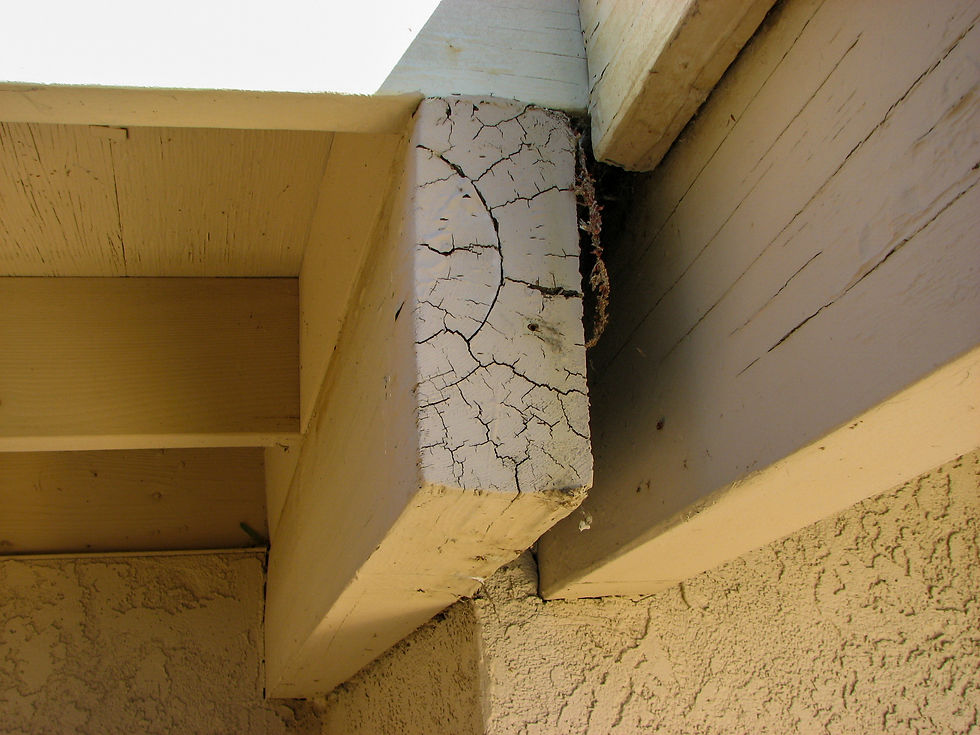Spottin’ the Rotten: understanding the nature of roof beam dry rot
- The Beam Guy
- Sep 3, 2020
- 3 min read
Updated: Aug 2, 2024
Roof beams are in a constant battle against wood rotting fungi and the ensuing decay. Due to their exposure, projections (the parts sticking out beyond the roof edge) are usually the first area of a beam to show evidence of decay. With simply no protection, they get ravaged by the blistering sun at one extreme, and drenched by rains at the other. Their end-cuts (or more specifically, the end grains) are particularly susceptible to this kind of punishment.
End-cuts with failed coatings (paints and the like), for example, will draw in moisture like a sponge—only to become bone dry later. Deep end-cracking eventually develops and can take on the appearance of parched desert clay. Since these crevices are prime breeding grounds for wood rot funguses (or fungi), it makes them a pretty good place to start "spottin' the rotten."

But any area of a roof beam can develop decay from dry rot fungi. The visible damage can range anywhere from a faint patch of surface discoloration all the way to sloughed-off rotted debris lying below what used to be a serviceable roof beam. Unfortunately, most roof beam dry rot deterioration leans toward the moderate range because minor decay doesn’t really draw much attention —allowing the wood rotting fungi to spread unabated.

Common radial cracks on any of a beam’s surfaces can create a cozy nursery for hungry fungi as well. (These typically lengthwise cracks are almost always a result of the original drying process and are almost never a structural concern.) Those that run along the top and sides of a beam projection are particularly vulnerable to fungus growths; moisture — the lifeblood of wood decay — can flow freely into these crannies.
Fungus: The Disintegrator
Well, now that words like “lifeblood” are being thrown around, a few words on fungi should be too. Imagine the nature of a fungus in wood as being a lot like that of a mold in bread; it seems to appear out of nowhere, then grows to abundance as its unsuspecting prey shrivels away. With roof beam overhangs, certain types of microscopic fungus spores find their way (mostly by natural means) into even the smallest of openings. By throwing in sufficient amounts of moisture, air, mild temperatures and time, the fungus can readily form and spread. Growth typically slows approaching the extremes of 32°F and 100°F and can even go dormant; active growth, though, will usually resume when conditions are favorable again.
By using certain components of the wood as food (see image below), the growing fungus will eventually strip a beam of its strength, serviceability, function and beauty. As it does, the fungus (depending on its variety and stage of development) can take on all sorts of hideous forms. Finding swollen porous masses (mycelium) and their sprawling root-like growths—inside and outside of the beam—is not uncommon. In time, there will be enough mycelium to support the outgrowth of fruiting bodies (brackets, mushrooms, and the like). The appearance of these fruiting bodies is a good indication that there’s a significant amount of decay in the beam. These growths are also the part of the fungus that ejects the next new batch of spores—starting the cycle all over again.

(image resourced from Dr. Jessie A. Glaeser)
In California where I live and work, the most common wood-rotting fungi I encounter in roof beams is brown rot. It thrives on the likes of pine, spruce and douglas fir. Over time, roof beams infected with brown rot fungus will become fragile. The resulting end grain cracking is checked and takes on that "parched desert clay" appearance. Beams with brown rot can become structurally weakened in a relatively short period of time.
(Brown rot is the likely explanation for the colloquial "dry rot" because once it has extracted all of the nutrients from the wood, the wood's appearance tends to be dry and powdery -- leaving one with the impression that dry wood has rotted. The irony is that "dry rot" doesn't happen in dry wood; it requires water.)
In an ideal environment, wood decay fungus is wickedly hungry. After it consumes every nutritious substance within the beam (that conditions will allow), the fungus will begin cannibalizing its own older parts to feed its new growth. With no healthy wood left to easily attack, the death of the remaining fungus is imminent; it too will eventually decompose. At this stage, the damage is done; the original infection (that can no longer be described as a fungus) has left behind the withered remains of what can no longer be defined as wood.

To go to my home page click
* parts of the above are excerpted from a roof beam dry rot repair book I'm currently writing



Коментарі